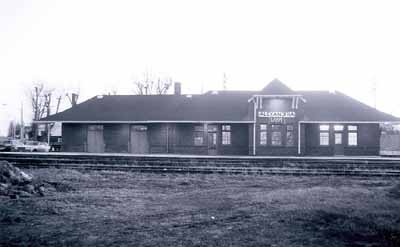VIA Rail/Canadian National Railways Station
Heritage Railway Station of Canada
Alexandria, Ontario

General view
(© Heritage Research Associates Inc., Nancy Fairbairn, 1992.)
Address :
27 McDougall Street, Alexandria, Ontario
Recognition Statute:
Heritage Railway Stations Protection Act (R.S.C., 1985, c. 52 (4th Supp.))
Designation Date:
1994-06-05
Dates:
-
1916 to 1917
(Construction)
Event, Person, Organization:
-
Grand Trunk Railway
(Organization)
Other Name(s):
-
Grand Trunk Railway Station
(Other Name)
-
Canadian National Railways Station at Alexandria
(Other Name)
Research Report Number:
RS-214
Description of Historic Place
The VIA Rail/Canadian National Railways Station at Alexandria is a one-and-a-half-storey, brick-clad, railway station built during the First World War. It is located at the north end of the town of Alexandria. The formal recognition is confined to the railway station building.
Heritage Value
The VIA Rail/Canadian National Railways Station at Alexandria represents the end of an era of growth and prosperity for Canadian railway companies. It reflects the Grand Trunk Railway’s (GTR) response to the need for adequate rail transportation during the First World War. The Alexandria station enabled the town to continue as a railway centre throughout the war.
The Alexandria railway station was one of a very small number of GTR stations built in Ontario during the First World War. Its simple design, brick construction and sparing use of scarce materials reflect wartime constraints.
The station retains its relationship with the railway tracks, and with surrounding industrial facilities, evident in the warehouse to the east and a grain elevator across the tracks.
Sources: Heritage Character Statement, VIA Rail/Canadian National Railways Station, Alexandria, Ontario, August 1994; Heritage Research Associates Inc., Railway Station Report 214, VIA Rail/Canadian National Railways Station, Alexandria, Ontario.
Character-Defining Elements
Character-defining elements of the VIA Rail/Canadian National Railways Station at Alexandria include: its design and materials reflective of wartime constraints, including: its simple form, minimal decorative details, sparing use of lumber and brick, solid-wall construction; its simple massing, consisting of a low, one-storey, rectangular block with a hipped, slightly bell-cast roof and a prominent, hipped, cross-dormer and a long, slightly narrower, hipped-roof east wing; the shallow jogs in the wall plane that are echoed in the line of the eaves; its features typical of early-20th-century railway stations, including a broad, hipped roof, a rectangular plan, wide overhanging eaves and a projecting operator’s bay; the projecting operator’s bay, centrally located on the track (north) side of the main block, rising above eave level, and terminating in a prominent, hipped-gable dormer; the projecting entrance bay, centrally located on the street (south) side of the main block, and matching the operator’s bay in configuration and detailing; the surviving original wood detailing, including decorative rafter ends under the eaves, narrow boarded soffits and prominent, paired brackets supporting the overhanging eaves of the hipped cross-dormers; the masonry detailing, including the Flemish, cross-bond brickwork of the walls, a diamond brick pattern and soldier-course border around the signboard in the track-side dormer and a strong horizontal soldier-course at window-sill height; the pattern of openings, consisting of symmetrically arranged groupings of multi-paned windows, transoms and glazed doors; the surviving original doors and window units; the remnants of its original interior plan, consisting of the passenger block with agent’s office and washrooms flanked by spacious waiting rooms and an east wing divided into two equal spaces for freight and express functions; the surviving original interior finishes, including, tongue-and-groove wood wainscot, plaster walls and ceilings and wood floors.